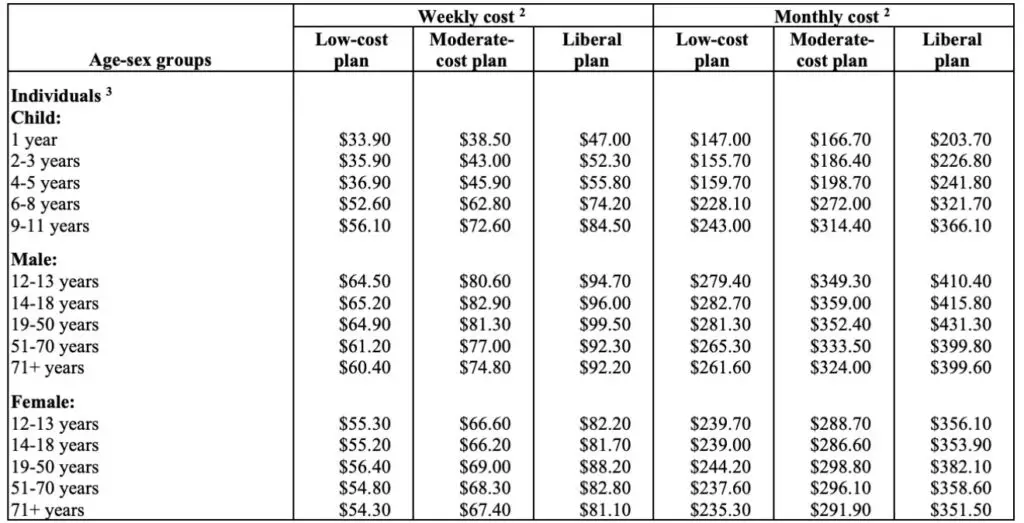We are all feeling the effects of inflation, especially at the grocery store. Food costs are trending up.
According to the U.S. Department of Agriculture, “Food price increases are expected to be above the increases observed in 2020 and 2021. In 2022, food-at-home prices are predicted to increase between 7.0 and 8.0 percent.”
When faced with the average cost of food increasing while our salaries stay the same many are wondering how much money they should be budgeting for groceries per month.
How Much Should I Budget For Groceries Per Month?
The exact amount that each person or family should budget towards grocery shopping will vary based on a few different factors. The size of your family, age of each family member, income level, and even the location that you live will all impact your monthly grocery budget.
The United States Department of Agriculture has provided some detailed information that can help you determine the best way to approach your monthly food budget.
Average Cost Of Food For The Average U.S. Household
The USDA estimates that the average cost of groceries for a single person is between $229 and $419.
That amount may or may not be very realistic for your family and your personal financial goals.
It is important to note that the averages from the USDA are calculated at three levels: low-cost or thrifty plan, moderate plan, and liberal plan. Therefore, taking a look at some of the factors that impact the national averages on food spending will give you a better idea of what price point best fits your family.

Grocery Spending By Location
Looking at the cost of common food items across different parts of the country is a great litmus test to help you adjust your grocery spending. I find that the easiest way to accomplish this is to look at the price of a gallon of milk.
A gallon of milk is a common item on the shopping list of any average household. When you see the wide variety in cost for a gallon of milk it will give you a better idea of what kinds of prices to expect for grocery items at your local grocery store.
Cost For A Gallon Of Milk By Location
These prices are for one gallon of whole milk as of May 2022.
| Atlanta GA | $4.29 |
| Baltimore, MD | $4.64 |
| Cleveland, OH | $3.63 |
| Dallas, TX | $3.90 |
| Miami, FL | $4.43 |
| New Orleans, LA | $4.87 |
| New York, NY | $4.95 |
| Oklahoma City, OK | $4.06 |
| Phoenix, AZ | $3.69 |
| Sacramento, CA | $4.72 |
| Seattle, WA | $4.16 |
| Wichita, KS | $3.36 |
Seeing how much the cost of a gallon of milk can vary from one state to the next tells me that a one size fits all average spending is just not realistic. Between New York, NY and Wichita, KS there is a difference of $1.59 for a gallon of milk. Trying to tell a family in New York that they should only spend as much on groceries as a family in Kansas is unrealistic.
Keep this in mind as you are determining a starting point in budgeting for groceries per month.
It is simply not a one size fits all answer.
For more information on how specific food prices have increased look at this chart from the U.S. Bureau Of Labor Statistics.
Average Grocery Budget Per Family Size
The size of your family and age of each family member is going to be a huge factor in how much money you budget for groceries each month.
Understanding that the numbers of family members impacts your budgeting for groceries per month is fairly self explanatory. However, when you also take into account the age and sex of each family member you can help get a better idea of your family’s average food budget.
Of course an adult female and adult male will have different requirements for food. This chart from the USDA gives a very thorough breakdown.

Food Shopping Costs By Income
The amount of money that U.S. households are budgeting for groceries per month also varies based on the income level of each household.
Households with a higher income spend more money on food. However, the amount they spend still represents a smaller percentage of their overall household budget.
According to the Economic Research Service of the USDA, in 2020 families in the lowest income quintile spent as average of $4,099 on food. This accounted for 27% of the total income. Households in the highest income quintile spent an average of $12,245 on food. This amount only accounted for 7% of their total income.

How Can I Save Money On Groceries?
What does all of this mean when it come to saving money at the grocery store?
With the rising costs of food and looking at how you are budgeting for groceries per month you are probably wanting to know how you can save money on groceries. Regardless of if you are on a tight budget or not it is possible to cut back on your average food budget.
Top 3 Tips To Lower Your Monthly Grocery Bill
- Cook at home
- Do not have brand loyalty
- Stick to the dirty dozen for organic products
Cook at home
Restaurant meals and fast food are always more expensive than cooking food at home.
While the cost of cooking food at home has risen by 2% the cost of eating at restaurants has increased by 9%.
If you are looking for easy ways to avoid spending a lot of money on food then the first place you should address is how often you are eating out.
Getting fast food can be convenient but there are a lot of great ways that you can eat a nutritious diet while still minimizing the amount of time that you spend in the kitchen. Two things to consider are putting your freezer to good use and using an instant pot or slow cooker.
Do not have brand loyalty
Choosing generic brands whenever possible is another way to cut back on your food expense.
Generic brands almost always have lower prices for the same level of quality and same ingredients that you are used to with name brands.
Recently at my own local grocery store I found that the store brand of diced tomatoes was a full dollar cheaper than the name brand version. The two items had the exact same ingredients, almost identical nutritional information, and both tasted great.
When you are looking at saving $0.25, $0.50, or even $0.10 it may not seem like a lot of money at first but those nickles and dimes add up over time. Shopping generic or store brand items is a good idea if you are trying to cut back on your budgeting for groceries per month.
Organic produce and the dirty dozen
The different cost levels between traditional versus organic food is evident. Organic foods are more expensive.
Depending on your family’s needs you may not need to shop for any organic food. However, if you are looking to purchase organic consider only buying those items that are on the dirty dozen list and selecting the non-organic options for the rest.
You can feed your family whole foods full of fresh fruits and vegetables without purchasing organic.
More Resources:
How To Save Money On Groceries (5 Easy Ways)
How Can We Avoid Food Waste At Home?
Nothing is more frustrating than wasting food. This is especially true when you are already working so hard to save money on your groceries.
Avoid food wastage at home is possible and it does not need to be overly complicated.
The best way to avoid food waste at home is by using a meal plan.
Meal Planning For The Average Family
Meal planning is a great way to both lower your monthly grocery budget as well as prevent food waste. If you are new to meal planning or have tried with little success in the past please do not be discouraged.
Meal planning can be done!
I have a full post that walks you through the process of creating a meal plan as well as provides you with a (free) complete meal plan. The free meal plan has a weeks worth of meals, all the recipes you need, and your grocery list. You can find all of that information by clicking this link.
How To Meal Plan
The steps for creating a meal plan are simple.
- Determine how many meals you need for the following week. (Ex. if you are having dinner with a friend one evening you will not need to prepare a meal)
- Make a list of the foods that you will serve at each meal. Do not forget to include any snacks.
- Using the list of foods make a separate list, your grocery list, of all the ingredients you need to purchase in order to make those meals. Do not forget to check your kitchen to see what ingredients you already have that do not need to be purchased.
- Implement the plan! Having a meal plan created is only half of the battle. You have to actually cook the meals you planned to and purchased groceries for in order to see the rewards.
How Can I Save $100 A Month For Groceries
- Shop The Sales
- Introduce Other Forms Of Protein
- Eat Seasonally
- Choose Frozen Produce
- Buy In Bulk
Shop The Sales
Pay attention to the sales that are being run in your local grocery store. A great way to do this is by looking at the weekly sales ad the stores puts out.
The best deals will always be on the front page of the ad.
You can take a look at the sales and use that information to help you determine what your meal plan will be for the week.
Another great place to look is discount stores such as Aldi if they are available in your area.
Pay special attention to sales when you are purchasing meat. Meat is one of the more expensive items on your grocery list so try to purchase it on sale when you can. Discounted meat can always be frozen to use at a later time.
Introduce Other Forms Of Protein
As I just mentioned meat is expensive and will make a large dent in your grocery budget. Introducing other forms of protein in place of meat will help to save you money.
You do not need to commit to being a vegetarian to take advantage of the savings. However, if you can replace even just one or two meals with beans or eggs as a protein you will see the savings.
One way that we like to do this in our house is to have breakfast for dinner. Not only does it save money but it is fun to mix things up and everyone enjoys it. I will make eggs, pancakes or waffles, and serve fruit on the side. Yum!
Eat Seasonally
Choosing seasonally food when you are buying fresh produce is an excellent way to save money. The seasonal produce is typically in abundance, easier to source, and therefore less expensive.
Another great way to do this is by shopping at a local farmers market. Many times farmers will offer wonderful seasonal produce that is very affordable. Of course this will vary based on your area so shop around and see what makes the most sense for you when you’re budgeting for groceries per month.
Choose Frozen Produce
Frozen produce is often times less expensive than fresh produce.
One concern you may have is if frozen produce is as healthy as fresh. The good news is that frozen produce is very similar nutritionally to fresh produce. There are slight nutrient decreases in the frozen foods but they are generally very small.
You can feel good about serving your family frozen produce. It is healthy and it is great for your wallet.
Buy In Bulk
Purchasing bulk items, especially when it comes to dry goods, can save you money. The amount that you spend up front will be more but the savings will come over time with each use of the product.
Before you purchase any bulk items do your research to make sure that the price per unit is cheaper. It almost always is but best practice is to be certain.
You will also want to be confident that you have the proper storage for whatever item you are purchasing. If the food goes bad, is exposed to bugs, or you simply have no where to put it then you are not reaping the savings you hoped for.

How Much Should I Budget For Food Per Month?
I have given you a lot of information as well as a lot of numbers and statistics.
The bottom line is that there is not a one size fits all answer when it comes to budgeting for groceries per month. Each family is unique and therefore each budget will be unique.
What we can do however is to take this information and apply it to ourselves in order to come up with the best averages for our family and make adjustments from there as needed.
Spending money on nourishing food for your family is not bad.
If you are struggling with food prices and looking for extra money in your budget there are several areas that you can cut back on. Take a hard look at your spending habits. Consider meeting with a financial adviser. Wanting to cut back on your grocery budget is reasonable but if you are struggling to find ways to serve healthy meals on a low budget you can always consider cutting back in other areas.
More Resources:
How To Budget As A One Income Family
How Much Money Do You Spend On Food Each Month?
Now I would love to hear from you! Let me know what your monthly grocery budget is like and what areas you are struggling with.
Do you create a monthly budget for food?
Do you find that your monthly food bill is rising?
What things are you doing to save money on groceries?
Recommended Reading:
- How To Save Money On Groceries
- How To Meal Plan + Free Meal Plan
- How To Budget As A One Income Family
- Couples Money Tips
- How To Make Freezer Meals That Actually Taste Good




Leave a Reply